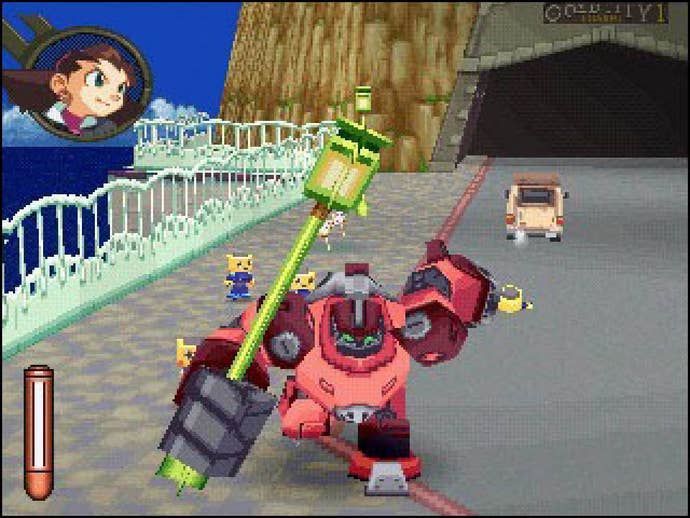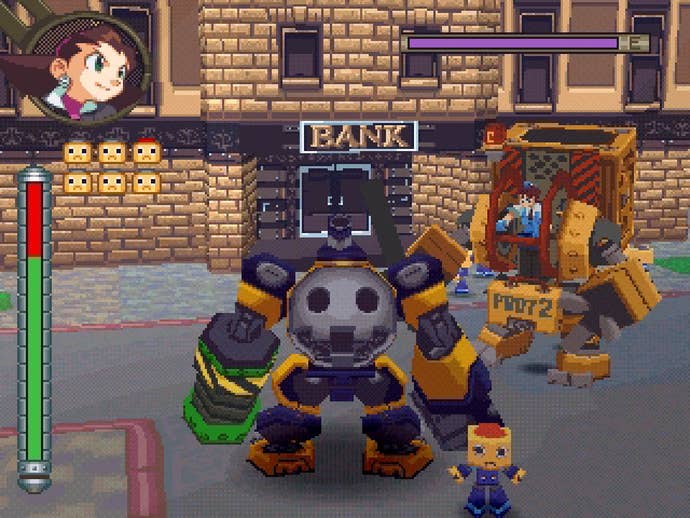In PlayStation's Misadventures of Tron Bonne, an Echo of Better Days
Back when Mega Man spinoffs had their own spinoffs (and we had Mega Man games, period).
This article first appeared on USgamer, a partner publication of VG247. Some content, such as this article, has been migrated to VG247 for posterity after USgamer's closure - but it has not been edited or further vetted by the VG247 team.
It may seem strange, in these dark days where Mega Man games are systematically canceled before they ever see release, that once upon a time the Mega Man series wasn't simply active -- it was thriving. Lately, Capcom has killed Mega Man projects on the vine like it's some kind of holy duty (see: Legends 3, Universe, Online, and that weird FPS Mega Man X reboot), but it wasn't always like that.
And so we have (or rather, had) The Misadventures of Tron Bonne, a Mega Man game so far removed from Mega Man you wouldn't even recognize it as such. There are exactly two references to the original games in the entirety of this brief but satisfying adventure: If you send your Servbot minions into a seemingly unremarkable house to plunder it, you're treated to a cutscene in which those lackeys laze about, reading comics and playing Mega Man for NES. Later, you can steal crates of food from a shipping company owned by a guy named Wily. Otherwise, though, Misadventures exists as a standalone prequel to Mega Man Legends, a game that eventually turned out to be the furthest-future point on the entire Mega Man timeline but really has very little in common with the 2D action games that otherwise comprised the series.

Instead, Misadventures followed the exploits of the Bonne family, the pirates who created most of the conflict in Legends but ultimately lent a helping hand once they recognized the much larger threat at hand and that Mega Man was the only one with the ability to keep the population of an entire island (including the Bonnes, who were there to seize its booty) from being wiped off the face of the planet. As this side story takes place well before that episode, though, here we saw the Bonnes as unrepentant plunderers through and through, hovering over a hapless island in their dirigible-like airship the Gessellschaft and strip-mining the land of every scrap of wealth they could find: Cash, refractor gems, foodstuffs, and more.
Yes, Misadventures was a Mega Man game that cast players as the villain, doing terrible things. Two years before Grand Theft Auto III made evil mainstream! Of course, this being Mega Man, your pillaging and looting worked out to be the furthest thing from grim murder simulation; for starters, you controlled a teenage girl, and your minions in crime were a troupe of 40 pint-sized robots with the personalities of children. They asked such dark, hard-hitting questions as "Do piggies bite?" One of the most challenging battles in the game consisted of a fight against a giant mechanical hippopotamus in which your key tactic was to launch your robot assistants into its nostrils so it had to breathe through its vulnerable mouth parts. Misadventures operated on its own goofy internal logic, the kind of logic that actively encouraged you not to think too hard about it.

Anyway, it's not like Tron and her clan were really evil. Sure, they were thieving everything in sight, but it was all for a good cause: A far more nefarious business man (Lex Loathe) and his enforcer Glyde (whose penguin-like Birdbots stood as a surly mirror image of Tron's doe-eyed Servbots) called in the loan Bonne patriarch Tiesel took out in order to build the Gessellschaft and vowed to hold both Tiesel and baby Bon Bonne captive until Tron could scare up several million zenny. What's a girl to do but swipe everything that isn't bolted down and sell it on the black market? Family is family, after all.
In practice, this equated to a game with mechanics as loosely connected to Mega Man as its characters and story. There was shooting, yes, but that's about it. Misadventures toed the borderline between action game and minigame collection, unfolding as separate, discrete missions. Certain missions played with a 3D run-and-gun style somewhat similar to Legends; I stress somewhat, because Tron after all was just a normal girl rather than whatever hybrid robotic abomination of nature the Mega Man of Legends was meant to be. Rather than simply running about on her own steam, she employed several different forms of mechanized armor (called Gustaff), and the Servbots tagged along behind her. While Tron could simply rely on Gustaff's arm cannon to get most of her dirty deeds done, the Servbots helped her reach places and perform maneuvers too delicate for her clumsy armor suit. They could also help in combat, leaping on enemies to damage, distract, and antagonize them.

Handily, while the Servbots could be stunned briefly, they were effectively invincible, so the only thing preventing you from abusing them in battle was your sense of sympathy. Misadventures didn't really bank on you worrying about the happiness of little robot men, though, given that the most effective means of powering them up between missions was to run them through grueling gauntlets of abuse. Each of the 40 Servbots had its own distinct personality, individual stats, and often a special ability as well. Somewhere along the way, you even had the opportunity to designate one Servbot as your favorite, which came into play during the final mission, which saw Tron being kidnapped alongside her brothers and the Servbot with the special red headpart taking control of the Gustaff to bust into Loathe's headquarters to rescue the Bonne family.
However, pure action provided only a single facet of the Misadventures equation. Many of the missions transpired as puzzles or adventures, and though these used the same basic engine as the more traditional game they each came with their own restrictions. The adventure mode took place through a first-person mode as Tron guided her Servbots remotely with a small drone with no real combat capabilities; rather than dealing with hazards and obstacles directly, players had to issue simple orders to the Servbots. In keeping with adventure game tradition, these sequences made heavy use of NPC interaction, and fellow adventurers would offer advice to the Servbots (evidently unaware that the little guys were there to strip their island home of any asset of value).

The puzzle sequences, on the other hand, used a special tank-like heavy labor mode of the Gustaff to swipe shipping crates by means of a Sokoban-inspired grid game. The Gustaff could only move a limited number of spaces per round, and certain obstacles could be lifted but not carried. Tron's mission was to steal a set number of crates from each harbor, with particularly clever players potentially able to snag the special bonus crates for extra cash rewards. Unlike the other modes, the puzzle mode didn't present Tron and the Servbots with any significant threats. The only challenge was to complete each stage within a given number of moves -- which itself became quite tough in the latter puzzles.
While, as a spinoff of a spinoff, Misadventures of Tron Bonne could have been a slapdash effort, in reality it proved to be anything but. Although its lower budget showed through in its brevity and the use of simple character portraits for dialogue sequences (rather than the fully animated 3D cut scenes of the proper Legends games) the game never felt cheap. It oozed with personality and wonderful little details, thanks in large part to the Servbots. The mission, puzzle, and adventure stages may have been fairly small, but they rewarded experimentation with all sorts of funny and surprising Easter eggs, and simply chatting with the little guys stationed about the Gessellschaft between missions would constantly yield new and often unusual conversations.
Misadventures is one of those fantastic PlayStation gems that's only come to seem better with the passing of time. It's not just that it's a relic from an age when we were practically drowning in Mega Man games, all of which were pretty good, but it also represents a bygone era when publishers could afford to dabble in a frivolous side project like this, and it could be wonderful. Despite being a quirky little experimental side project, Misadventures went a long way toward enriching the Legends universe (many of its concepts and characters appeared in Legends 2). And it was a great little game in its own right, too -- through brief, its bite-sized structure and general sense of fun made it perfect replay fodder, like the original Mega Man games. The only real downside to Misadventures is that Capcom underproduced it and has never reissued it, meaning it ranks up there with Suikoden II for pricey PlayStation cult classics. A pity, because it's a perfect example of how to explore fresh ideas with an aging franchise. If only Capcom were still willing to apply that sort of invention to Mega Man today.
